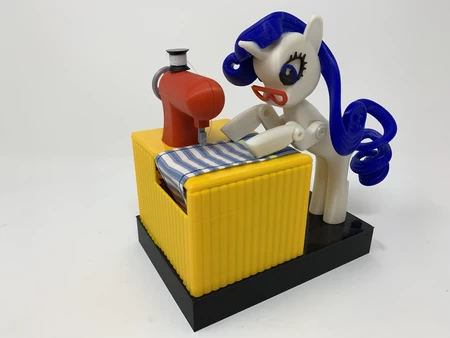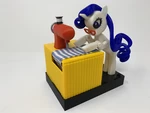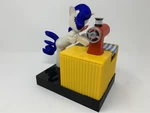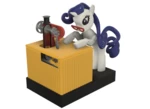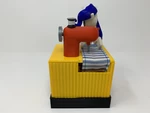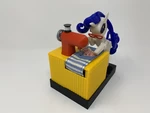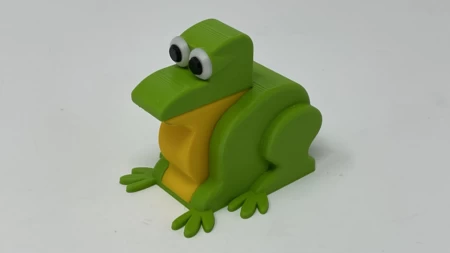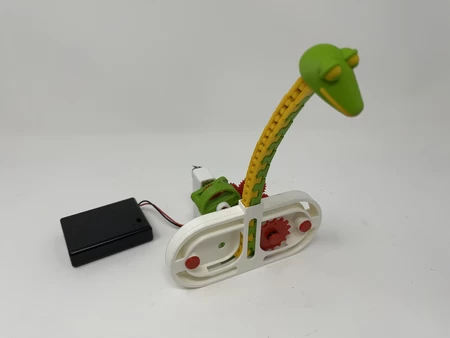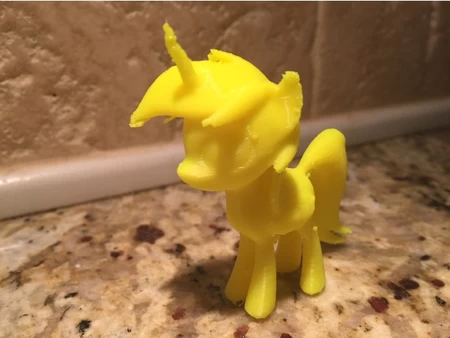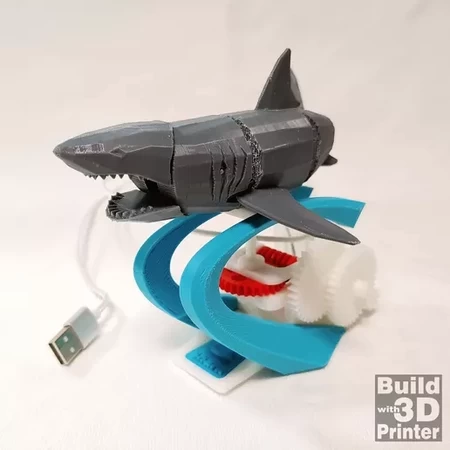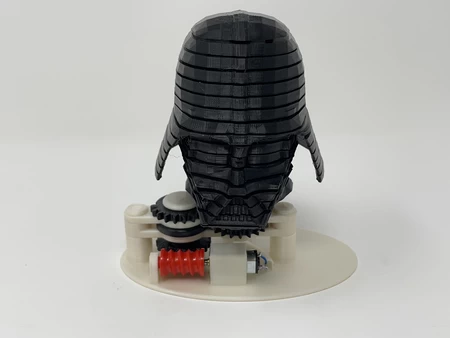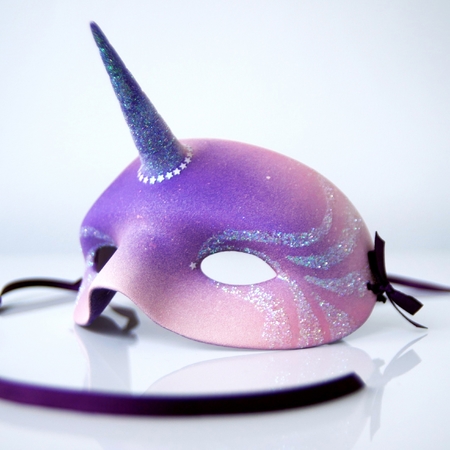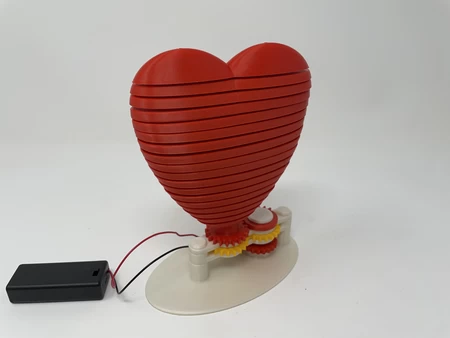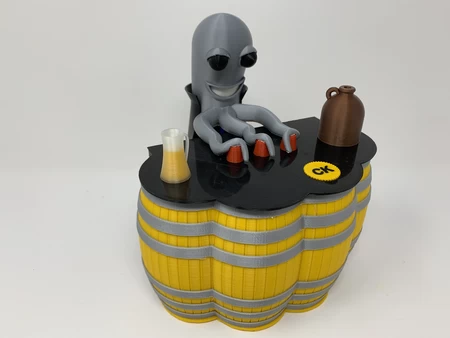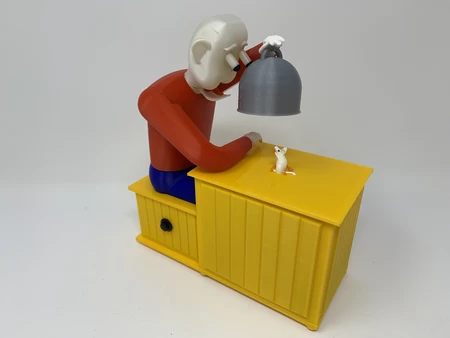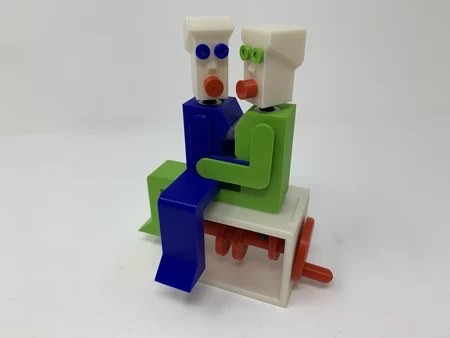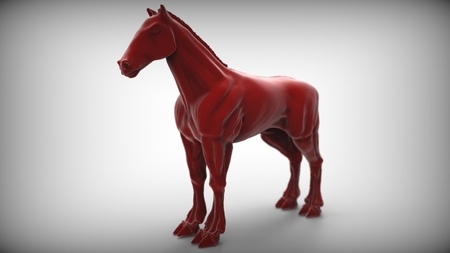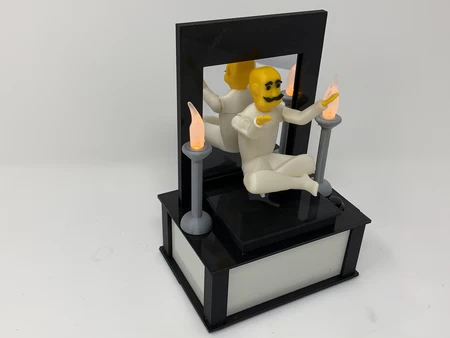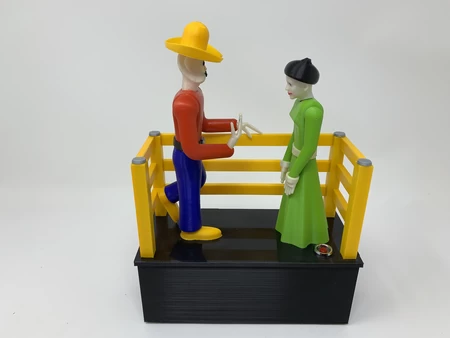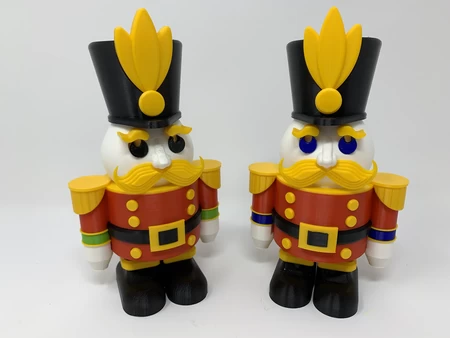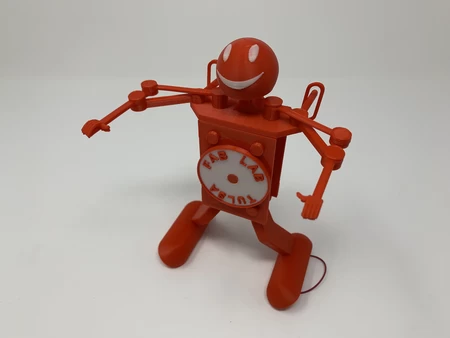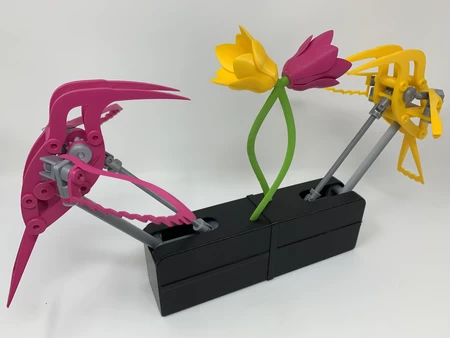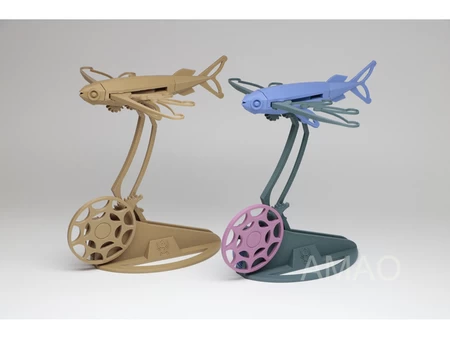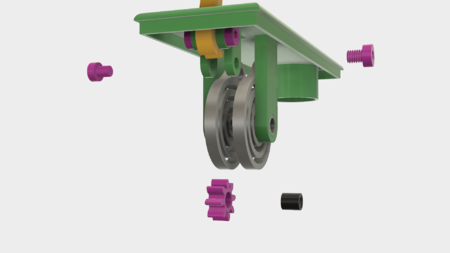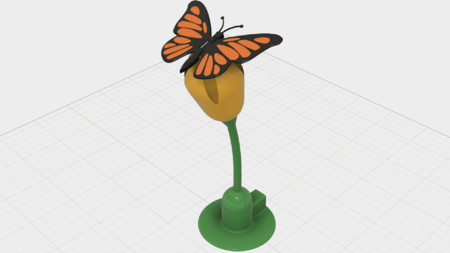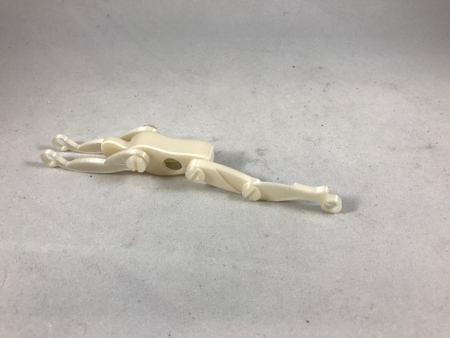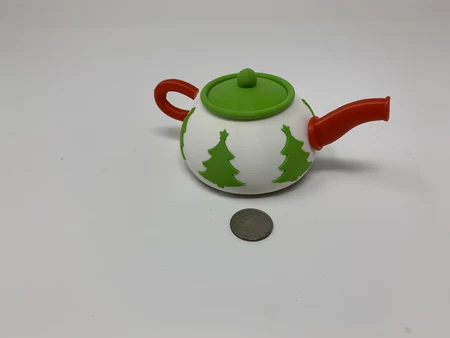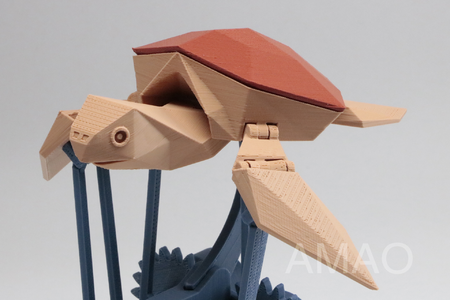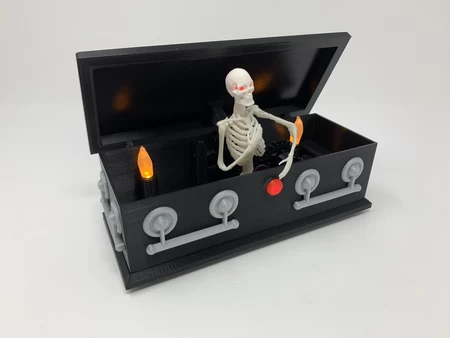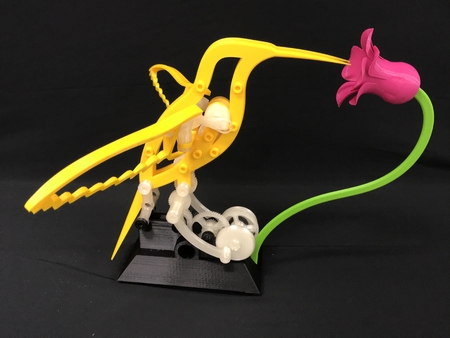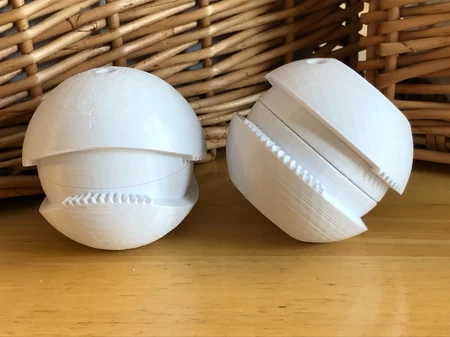“rarity”——一个 3d 打印的自动机器人 3D打印
3349 视图 2 喜欢 0 下载 下载
https://youtu.be/P9ws9W3nZrs
我们最喜欢的寿司店的一位女服务员爱上了 morisato54 (YouTube) 的自动机,�...�自动机以“我的小马驹”角色“Rarity”为特色,并问我是否可以设计、3D 打印和组装该模型的复制品,所以这是我第一次尝试她的挑战。
正如关注我的人所知,我不是艺术家,这个模型对我来说是一个挑战,尤其是头发和尾巴的特征。我最终决定在我的 Ultimaker S5 上使用 PVA 作为支撑将头发特征分成两部分打印。我的缝纫技巧同样具有挑战性,所以我的妻子介入缝制视频中出现的测试面料,并为模型选择各种颜色。
像往常一样,我可能忘记了一两个文件,或者谁知道还有什么,所以如果您有任何问题,请不要犹豫,因为我确实犯了很多错误。
使用 Autodesk Fusion 360 设计,使用 Cura 4.6.1 切片,并在 Ultimaker 2+ Extended、Ultimaker 3 Extended 和 Ultimaker S5 上使用 PLA 进行 3D 打印。
我获得了以下零件:
• 十个 6 毫米(直径)x 1.5 毫米(厚度)钕磁铁(当地业余爱好商店)。
• 六个 3... 毫米(直径)x 1.5 毫米(厚度)钕磁铁(当地业余爱好商店)。
• 一个 N20 6VDC 100RPM 齿轮马达(在线)。
• 一个 R07 O 形圈(10 毫米 ID,2.5 毫米截面,我的个人 O 形圈储藏)。
• 一个 O 形圈(1 7/8 英寸 ID,3/32 英寸截面,管道用品商店)。
• 一个带开关的 AAA 四电池座(在线)。
我 3D 打印了所有零件,如附件“Parts.pdf”中所述。
该机制是高精度打印和组装,有时在狭窄空间内使用非常小的精密 3D 打印零件,并进行高度精确的对准。我使用 Ultimaker S5 上的 Ultimaker Cura 4.6.1“工程配置文件”打印了齿轮、杠杆、臂、凸轮和轮子,它提供了高度精确的公差,几乎不需要任何修整、锉平、钻孔或打磨。然而,在组装之前,我仍然对所有部件进行了测试和修整、锉平、钻孔、打磨等,以确保移动表面平稳移动,非移动表面紧密贴合。根据您的切片机、打印机、打印机设置和您选择的颜色,可能需要或多或少地进行修整、锉平、钻孔和/或打磨才能成功重新创建此模型。我仔细地锉平了与构建板接触的所有边缘,以确保所有构建板“渗出物”都被清除,并且所有边缘都是光滑的,使用小型珠宝锉刀和足够的耐心来执行此步骤。
该机制还使用螺纹组装,因此我根据需要使用了丝锥和板牙套装(6mm x 1)来清洁螺纹。
缝纫机预组装。
对于缝纫机的预组装,我:
• 将“缝纫机,销,轴.stl”压入“缝纫机,轴.stl”中的孔中。
• 将“缝纫机,滑轮.stl”压到轴组件上。
• 将“缝纫机,轮子.stl”拧到轴组件上。
• 将轴组件放入“缝纫机,外壳,后部.stl”中,将滑轮与线轴安装销对齐,确保滑轮垂直于轴,然后用一小点胶水将滑轮固定到位。
• 将“缝纫机,针.stl”放在轴组件销上,并将其放置在后壳体中。
• 将“缝纫机,外壳,前部.stl”放在组件上,并用“线轴.stl”固定到位。
• 通过轴轮旋转轴以确保轴自由旋转。
缝纫机组装。
对于缝纫机工作台组件,我:
• 将“Pulley, Axle, Main.stl”和大 O 形环放置在“Sewing Machine, Table.stl”的开口上方。
• 将“Axle, Main (1.5m 20t).stl”滑过工作台主轴塔上的孔,然后穿过滑轮和 O 形环。
• 将“Gear, Axle, Main.stl”压在主轴组件的末端。
• 测试主轴组件以确保其自由旋转,然后使用一小点胶水将主轴齿轮固定到轴上。
• 将齿轮马达压入工作台组件。
• 将“Gear, Motor.stl”压在齿轮马达输出轴上。
• 将八个 6 毫米磁铁压入“Magnet, Mount.stl”,每个杯中四个,极性匹配。
• 将磁铁安装组件放置在工作台组件磁铁安装销上。
• 使用“Nut, Magnet Mount.stl”将磁铁安装组件固定到桌子组件上
• 测试磁铁安装组件是否能自由移动。
• 将“Axle, Magnet Mount.stl”拧入磁铁安装组件。
• 将滑块“Pin, Axle, Magnet Mount.stl”放入“Wheel, Magnet Mount.stl”中的无螺纹孔中,然后将 Pin, Axle, Magnet Mount 中的孔滑到 Axle, Magnet Mount 上,然后使用“Gear, Magnet Mount (1.5m 20t).stl”将轮子固定到桌子组件上。
• 在“Roller.stl”上较小轴的中心周围缠绕一层透明胶带。
• 按照图示将滚轮组件放入桌子组件中,然后使用“Bushing, Roller.stl”和“Gear, Axle, Roller.stl”固定到位。
• 定位“凸轮、臂、轭.stl”,然后用“齿轮、臂、轭 (1.5m 20t).stl”固定到位。
• 测试组件是否能自由移动。
• 将大 O 形环定位在主轴皮带轮和缝纫机轴皮带轮周围。
• 将轴组件放入后壳中。
• 将针头定位在轴销周围并放入后壳中。
• 将缝纫机前壳放置在组件上方。
• 将外壳与线轴固定在一起。
• 将缝纫机组件放入台式缝纫机开口中。
• 给电机通电,并将缝纫机垂直调整到缝纫机以最小张力在 O 形环上操作的程度,然后使用小点胶水将缝纫机固定在桌子上。
• 我的妻子剪了一条 9.5 英寸长、1 5/8 英寸宽的布条,然后将两端缝合在一起,重叠 1/2 英寸,形成一个环。我将材料环滑到桌子上的位置。
Rarity 组装。
对于 Rarity 组装,我:
• 将“Eye, Lash, Left.stl”、“Eye, Blue, Left.stl”和“Eye, Black, Left.stl”粘贴到“Head.stl”的左侧。
• 将“Eye, Lash, Right.stl”、“Eye, Blue, Right.stl”和“Eye, Black, Right.stl”粘贴到头部组件的右侧。
• 将“Hair, Back.stl”和“Hair, Front.stl”粘贴到头部组件。
• 将“Arm, Head.stl”压入头部组件。
• 将一个 6mm 磁铁压入手臂的磁铁孔中。
• 将“Glasses.stl”粘贴到头部组件。
• 将“Tail.stl”粘贴到“Body.stl”。
• 使用“Axle, Arm, Upper, Left.stl”将“Arm, Upper, Left.stl”连接到身体组件。
• 将头部组件滑入车身组件(这可能比较棘手),将头部臂轴孔与臂安装孔对齐,然后使用“Axle, Arm, Upper Right.stl”将头部组件和“Arm, Upper, Right.stl”连接到车身组件。
• 使用一个“Axle, Arm, Lower.stl”将“Arm, Lower, Left.stl”连接到左上臂。
• 使用剩余的“Axle, Arm, Lower.stl”将“Arm, Lower, Right.stl”连接到右上臂。
• 进行测试以确保上臂和下臂关节以及头部可以自由旋转。
• 将六个 3 毫米磁铁(每个下臂各三个)压入,与磁铁安装磁铁的极性相匹配。
最终组装。
对于最终组装,我:
• 将电池组电线焊接到电机上,以便材料被拉动,如视频中所示。
• 将线缠绕在线固定器上,并用小点胶水固定到位,然后将自由端粘在针头上。
• 将 Rarity 压入“Base.stl”(稍后将进行调整和固定)。
• 将较小的 O 形环放在“Wheel, O Ring.stl”上。
• 将轮子组件放入“Wheel, O Ring Carriage.stl”中。
• 使用“Wheel, O Ring Axle.stl”将轮子组件固定到托架上。
• 使用两个“Bolt.stl”将托架组件固定到底座组件上。
• 将一个 6 毫米磁铁压入“Yoke.stl”。
• 将轭组件(磁铁端在前)滑入主体的左腿,直到其连接到头臂中的磁铁。
• 将“Sewing Machine Table Skirt.stl”滑到桌子组件上。
• 使用四个“Bolt.stl”将桌子组件连接到底座组件上。
• 使用“Axle, Arm, Yoke.stl”将“Arm, Yoke.stl”连接到底座组件。
• 将轭架组件上的孔滑到轭架臂上的销钉上。
• 使用双面胶带将电池组连接到底座组件的底面。
• 给组件通电,然后调整 Rarity 的俯仰和滚动,直到实现臂运动,然后将 Rarity 粘到底座上。
这就是我 3D 打印和组装“Rarity,一个 3D 打印自动机”的方法。
希望你喜欢它!
设计师
Greg Zumwalt3D 模型描述
来自朋友的挑战。https://youtu.be/P9ws9W3nZrs
我们最喜欢的寿司店的一位女服务员爱上了 morisato54 (YouTube) 的自动机,�...�自动机以“我的小马驹”角色“Rarity”为特色,并问我是否可以设计、3D 打印和组装该模型的复制品,所以这是我第一次尝试她的挑战。
正如关注我的人所知,我不是艺术家,这个模型对我来说是一个挑战,尤其是头发和尾巴的特征。我最终决定在我的 Ultimaker S5 上使用 PVA 作为支撑将头发特征分成两部分打印。我的缝纫技巧同样具有挑战性,所以我的妻子介入缝制视频中出现的测试面料,并为模型选择各种颜色。
像往常一样,我可能忘记了一两个文件,或者谁知道还有什么,所以如果您有任何问题,请不要犹豫,因为我确实犯了很多错误。
使用 Autodesk Fusion 360 设计,使用 Cura 4.6.1 切片,并在 Ultimaker 2+ Extended、Ultimaker 3 Extended 和 Ultimaker S5 上使用 PLA 进行 3D 打印。
3D模型打印参数
零件。我获得了以下零件:
• 十个 6 毫米(直径)x 1.5 毫米(厚度)钕磁铁(当地业余爱好商店)。
• 六个 3... 毫米(直径)x 1.5 毫米(厚度)钕磁铁(当地业余爱好商店)。
• 一个 N20 6VDC 100RPM 齿轮马达(在线)。
• 一个 R07 O 形圈(10 毫米 ID,2.5 毫米截面,我的个人 O 形圈储藏)。
• 一个 O 形圈(1 7/8 英寸 ID,3/32 英寸截面,管道用品商店)。
• 一个带开关的 AAA 四电池座(在线)。
我 3D 打印了所有零件,如附件“Parts.pdf”中所述。
该机制是高精度打印和组装,有时在狭窄空间内使用非常小的精密 3D 打印零件,并进行高度精确的对准。我使用 Ultimaker S5 上的 Ultimaker Cura 4.6.1“工程配置文件”打印了齿轮、杠杆、臂、凸轮和轮子,它提供了高度精确的公差,几乎不需要任何修整、锉平、钻孔或打磨。然而,在组装之前,我仍然对所有部件进行了测试和修整、锉平、钻孔、打磨等,以确保移动表面平稳移动,非移动表面紧密贴合。根据您的切片机、打印机、打印机设置和您选择的颜色,可能需要或多或少地进行修整、锉平、钻孔和/或打磨才能成功重新创建此模型。我仔细地锉平了与构建板接触的所有边缘,以确保所有构建板“渗出物”都被清除,并且所有边缘都是光滑的,使用小型珠宝锉刀和足够的耐心来执行此步骤。
该机制还使用螺纹组装,因此我根据需要使用了丝锥和板牙套装(6mm x 1)来清洁螺纹。
缝纫机预组装。
对于缝纫机的预组装,我:
• 将“缝纫机,销,轴.stl”压入“缝纫机,轴.stl”中的孔中。
• 将“缝纫机,滑轮.stl”压到轴组件上。
• 将“缝纫机,轮子.stl”拧到轴组件上。
• 将轴组件放入“缝纫机,外壳,后部.stl”中,将滑轮与线轴安装销对齐,确保滑轮垂直于轴,然后用一小点胶水将滑轮固定到位。
• 将“缝纫机,针.stl”放在轴组件销上,并将其放置在后壳体中。
• 将“缝纫机,外壳,前部.stl”放在组件上,并用“线轴.stl”固定到位。
• 通过轴轮旋转轴以确保轴自由旋转。
缝纫机组装。
对于缝纫机工作台组件,我:
• 将“Pulley, Axle, Main.stl”和大 O 形环放置在“Sewing Machine, Table.stl”的开口上方。
• 将“Axle, Main (1.5m 20t).stl”滑过工作台主轴塔上的孔,然后穿过滑轮和 O 形环。
• 将“Gear, Axle, Main.stl”压在主轴组件的末端。
• 测试主轴组件以确保其自由旋转,然后使用一小点胶水将主轴齿轮固定到轴上。
• 将齿轮马达压入工作台组件。
• 将“Gear, Motor.stl”压在齿轮马达输出轴上。
• 将八个 6 毫米磁铁压入“Magnet, Mount.stl”,每个杯中四个,极性匹配。
• 将磁铁安装组件放置在工作台组件磁铁安装销上。
• 使用“Nut, Magnet Mount.stl”将磁铁安装组件固定到桌子组件上
• 测试磁铁安装组件是否能自由移动。
• 将“Axle, Magnet Mount.stl”拧入磁铁安装组件。
• 将滑块“Pin, Axle, Magnet Mount.stl”放入“Wheel, Magnet Mount.stl”中的无螺纹孔中,然后将 Pin, Axle, Magnet Mount 中的孔滑到 Axle, Magnet Mount 上,然后使用“Gear, Magnet Mount (1.5m 20t).stl”将轮子固定到桌子组件上。
• 在“Roller.stl”上较小轴的中心周围缠绕一层透明胶带。
• 按照图示将滚轮组件放入桌子组件中,然后使用“Bushing, Roller.stl”和“Gear, Axle, Roller.stl”固定到位。
• 定位“凸轮、臂、轭.stl”,然后用“齿轮、臂、轭 (1.5m 20t).stl”固定到位。
• 测试组件是否能自由移动。
• 将大 O 形环定位在主轴皮带轮和缝纫机轴皮带轮周围。
• 将轴组件放入后壳中。
• 将针头定位在轴销周围并放入后壳中。
• 将缝纫机前壳放置在组件上方。
• 将外壳与线轴固定在一起。
• 将缝纫机组件放入台式缝纫机开口中。
• 给电机通电,并将缝纫机垂直调整到缝纫机以最小张力在 O 形环上操作的程度,然后使用小点胶水将缝纫机固定在桌子上。
• 我的妻子剪了一条 9.5 英寸长、1 5/8 英寸宽的布条,然后将两端缝合在一起,重叠 1/2 英寸,形成一个环。我将材料环滑到桌子上的位置。
Rarity 组装。
对于 Rarity 组装,我:
• 将“Eye, Lash, Left.stl”、“Eye, Blue, Left.stl”和“Eye, Black, Left.stl”粘贴到“Head.stl”的左侧。
• 将“Eye, Lash, Right.stl”、“Eye, Blue, Right.stl”和“Eye, Black, Right.stl”粘贴到头部组件的右侧。
• 将“Hair, Back.stl”和“Hair, Front.stl”粘贴到头部组件。
• 将“Arm, Head.stl”压入头部组件。
• 将一个 6mm 磁铁压入手臂的磁铁孔中。
• 将“Glasses.stl”粘贴到头部组件。
• 将“Tail.stl”粘贴到“Body.stl”。
• 使用“Axle, Arm, Upper, Left.stl”将“Arm, Upper, Left.stl”连接到身体组件。
• 将头部组件滑入车身组件(这可能比较棘手),将头部臂轴孔与臂安装孔对齐,然后使用“Axle, Arm, Upper Right.stl”将头部组件和“Arm, Upper, Right.stl”连接到车身组件。
• 使用一个“Axle, Arm, Lower.stl”将“Arm, Lower, Left.stl”连接到左上臂。
• 使用剩余的“Axle, Arm, Lower.stl”将“Arm, Lower, Right.stl”连接到右上臂。
• 进行测试以确保上臂和下臂关节以及头部可以自由旋转。
• 将六个 3 毫米磁铁(每个下臂各三个)压入,与磁铁安装磁铁的极性相匹配。
最终组装。
对于最终组装,我:
• 将电池组电线焊接到电机上,以便材料被拉动,如视频中所示。
• 将线缠绕在线固定器上,并用小点胶水固定到位,然后将自由端粘在针头上。
• 将 Rarity 压入“Base.stl”(稍后将进行调整和固定)。
• 将较小的 O 形环放在“Wheel, O Ring.stl”上。
• 将轮子组件放入“Wheel, O Ring Carriage.stl”中。
• 使用“Wheel, O Ring Axle.stl”将轮子组件固定到托架上。
• 使用两个“Bolt.stl”将托架组件固定到底座组件上。
• 将一个 6 毫米磁铁压入“Yoke.stl”。
• 将轭组件(磁铁端在前)滑入主体的左腿,直到其连接到头臂中的磁铁。
• 将“Sewing Machine Table Skirt.stl”滑到桌子组件上。
• 使用四个“Bolt.stl”将桌子组件连接到底座组件上。
• 使用“Axle, Arm, Yoke.stl”将“Arm, Yoke.stl”连接到底座组件。
• 将轭架组件上的孔滑到轭架臂上的销钉上。
• 使用双面胶带将电池组连接到底座组件的底面。
• 给组件通电,然后调整 Rarity 的俯仰和滚动,直到实现臂运动,然后将 Rarity 粘到底座上。
这就是我 3D 打印和组装“Rarity,一个 3D 打印自动机”的方法。
希望你喜欢它!
